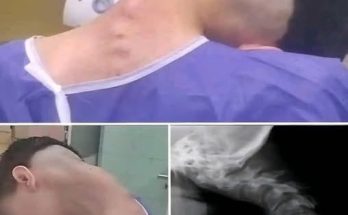Shingles, medically known as Herpes Zoster, is a viral infection that causes a painful rash with blisters. It is caused by the reactivation of the varicella-zoster virus (VZV), the same virus that causes chickenpox. After you’ve had chickenpox, the virus lies dormant in your nerve cells and can reactivate years later, often when your immune system is weakened.
While the sensation of “Shingles being everywhere” refers to its pervasive and intense nature, it’s important to clarify that the rash itself typically appears in a localized band or strip on one side of the body, following the path of the affected nerve. It does not literally spread all over the body in the same way as chickenpox. However, for the person experiencing it, the pain and discomfort can feel overwhelming and widespread.
How to “Heal It Fast!” (or more accurately, manage it effectively and promote healing)
There is no “instant cure” for shingles, but prompt treatment is crucial to reduce the severity and duration of the rash, alleviate pain, and prevent complications, particularly postherpetic neuralgia (PHN), which is persistent nerve pain after the rash clears.
Here’s how to manage shingles effectively:
1. Antiviral Medications (The Most Important Step for “Fast” Healing)
This is the cornerstone of treatment and should be started as soon as possible, ideally within 72 hours of the rash appearing (or even earlier if you experience prodromal symptoms like tingling or burning before the rash emerges).
- Medications:
- Acyclovir (Zovirax)
- Valacyclovir (Valtrex)
- Famciclovir (Famvir)
- How they work: These antiviral drugs reduce the severity and duration of the rash, accelerate healing, and significantly decrease the risk of developing postherpetic neuralgia (PHN). They work by inhibiting the replication of the varicella-zoster virus.
- Importance of timing: The earlier you start antivirals, the more effective they are. Do not delay seeing a doctor if you suspect shingles.
2. Pain Management
Shingles pain can be severe and debilitating. Effective pain control is essential for comfort and quality of life during an outbreak.
- Over-the-counter pain relievers:
- NSAIDs (Nonsteroidal Anti-inflammatory Drugs): Ibuprofen (Advil, Motrin), naproxen (Aleve) can help with mild to moderate pain and inflammation.
- Acetaminophen (Tylenol): For pain relief.
- Prescription pain relievers:
- Neuropathic pain medications: Gabapentin (Neurontin) or pregabalin (Lyrica) are specifically effective for nerve pain (neuropathic pain), which is characteristic of shingles. These can be started during the acute phase to help prevent PHN.
- Opioids: For severe, acute pain, your doctor might prescribe stronger pain medications for a short period.
- Tricyclic antidepressants: Amitriptyline, nortriptyline can also help with neuropathic pain.
- Topical pain relief:
- Capsaicin cream: Can be used on healed skin, but not on open blisters. It works by desensitizing nerve endings. Use with caution as it can cause burning initially.
- Lidocaine patches or creams: Can provide localized pain relief.
- Calamine lotion: Can soothe itching.
3. Blister Care to Prevent Infection
Keeping the rash clean and preventing infection is crucial for healing and preventing complications like bacterial cellulitis.
- Keep it clean and dry: Wash the affected area gently with mild soap and water daily. Pat dry.
- Cool compresses: Apply cool, wet compresses to the blisters to soothe pain and itching.
- Loose clothing: Wear loose-fitting, soft clothing that won’t rub against the rash.
- Do NOT pick or scratch: Resist the urge to scratch or pop the blisters, as this can lead to scarring and bacterial infection.
- Cover the rash: A non-adherent dressing can help protect the rash, reduce irritation from clothing, and contain fluid from weeping blisters.
4. Boosting Your Immune System (Long-Term Strategy)
While not a direct “fast” treatment, a strong immune system is essential for preventing shingles reactivation and for overall recovery.
- Rest: Get plenty of rest to allow your body to fight the virus.
- Balanced diet: Eat nutritious foods to support your immune system.
- Stress management: Stress can weaken the immune system; practice relaxation techniques.
5. Preventive Measures (Most Effective in the Long Run)
The absolute best way to “heal it fast” is to prevent it from happening in the first place or to reduce its severity significantly.
- Shingles Vaccine (Shingrix): This is highly effective (over 90%) at preventing shingles and PHN. It’s recommended for healthy adults 50 years and older, and for adults 18 and older who are immunocompromised. It is given in two doses, 2 to 6 months apart. If you’ve had shingles, the vaccine can help prevent recurrence.
When to Seek Immediate Medical Attention:
- If the rash is on your face, especially near your eye or tip of your nose: This could affect your vision and requires immediate ophthalmological assessment.
- If you have a weakened immune system: Due to conditions like HIV/AIDS, cancer, or medications.
- If the pain is severe and unmanageable with over-the-counter medications.
- If the rash shows signs of bacterial infection (increasing redness, swelling, pus, fever).
- If you experience weakness or drooping of one side of your face, or other neurological symptoms.
In summary, while there’s no magic bullet to make shingles disappear instantly, early intervention with antiviral medications, combined with effective pain management and good wound care, are the keys to promoting faster healing, reducing discomfort, and minimizing the risk of long-term complications like postherpetic neuralgia. If you suspect you have shingles, contact your doctor immediately.

